Our funding comes from our readers, and we may earn a commission if you make a purchase through the links on our website.
The Best Free Packet Sniffers & Network Analyzers
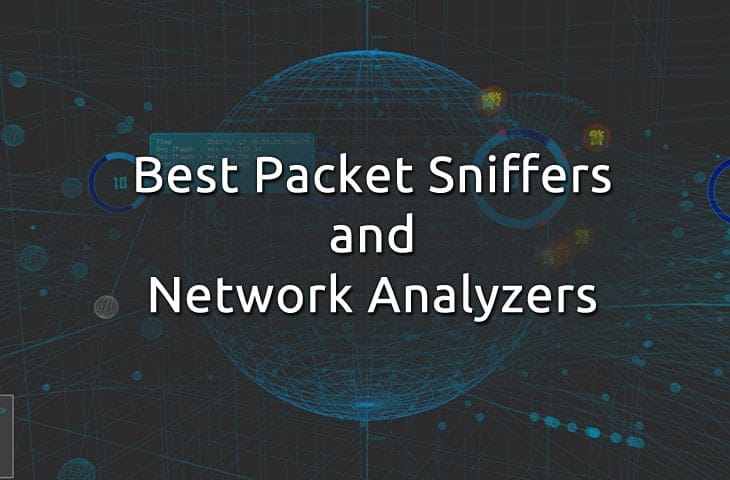
UPDATED: December 21, 2023
A packet sniffer, also known as a network analyzer, serves as an essential tool in various aspects of network management, troubleshooting, and cybersecurity. Its primary purpose is to capture and analyze network traffic, providing valuable insights into the data flowing through a network.
There are dozens of network analyzers on the market and this guide is not only a shortlist of our experts' favorite tools but will also help you choose the right packet sniffer for your organization.
Here is our list of the best packet sniffers and network analyzers:
- SolarWinds Bandwidth Analyzer Pack – EDITOR'S CHOICE A bundle of two network monitoring tools that watch device health and analyze traffic flows. The package includes real-time displays of packet information, which is derived from NetFlow data extractors, and also statistical functions that capture packets, analyze the header contents, and produces aggregated traffic characteristics. Installs on Windows Server. Start a 30-day free trial.
- ManageEngine NetFlow Analyzer – FREE TRIAL A traffic flow analyzer that can help implement traffic shaping measures as well. Runs on Windows Server and Linux. Start a 30-day free trial.
- Site24x7 – FREE TRIAL More than just a packet sniffer, it excels in network performance monitoring and management with deep traffic insights. Start a 30-day free trial.
- Wireshark A free packet capture and analysis tool that has a great graphical front-end for viewing traffic statistics. Available for Windows, Linux, Unix, and macOS.
- tcpdump A command-line no fills packet capture utility. Available for Linux, macOS, Unix, and Android.
- Kismet A free packet sniffer for wireless networks. Available for Linux, macOS, and Unix.
- EtherApe A free packet capture tool. Runs on Linux, macOS, and Unix.
- Network Miner Available in free and paid versions, this tool captures packets and displays them live on screen. Runs on Windows, macOS, Linux, and Unix.
- KisMAC Now revived as KisMAC 2, this free wireless packet sniffer can show live wireless signal heat maps. Runs on macOS.
Ultimately packet sniffing is the go-to tool when you've got a network issue that you can't quite isolate to a single machine or protocol and it's time to start digging deep.
There's almost too many choices in this category of software.
Some of them are a bit ‘old-school'; they're grounded in terminal font and command-prompt interfaces and aren't that user-friendly at first glance.
Others are flashy and much more geared towards a visual audience with easy installation, portable executables, and plenty of graphs and tables.
They also range from free to quite expensive for corporate licensing!
The Best Free Packet Sniffers and Network Analyzers for Traffic and Data Analysis
Our methodology for selecting packeting and network analyzers
We reviewed the network analyzer tools and software market and analyzed the options based on the following criteria:
- An autodiscovery system to log all network devices
- A network topology mapper
- The ability to collect live network devices statuses by using SNMP
- A facility to analyze network performance over time
- Graphical interpretation of data, such as charts and graphs
- A free trial period, a demo, or a money-back guarantee for no-risk assessment
- A good price that reflects value for money when compared to the functions offered
With these selection criteria in mind, we have identified some excellent traffic analyzers that have good reputations. We have selected systems that will install on Windows, Linux, macOS, Unix, and Android. Some of the options are paid tools but they offer long free trial periods.
Below is a list of some of the Best Packet Analyzers and Sniffers and some of the features that they have built-in for you to extract network information and data. They all tend to have the same sort of functionality – you can view packets being sent and received on some level or another, but many of the tools have certain nuances that allow them to shine in certain situations or network environments; the trick is knowing which one!
1. SolarWinds Bandwidth Analyzer Pack – FREE TRIAL
SolarWinds Bandwidth Analyzer Pack consists is a two-piece deal with similar, but distinct, functionality that goes hand in hand.
The Network Performance Monitor, as the name implies, monitors network performance and is going to be one of the Best Network Data Sniffers on the market if you want an overall view of what's going on in your network.
What this means, more plainly, is it pays mind to more of the pure motility of the network.
Transmission speeds and rates, packet transmission reliability, and even comes pre-configured with a wide variety of visual aids and sharp looking charts to make irregularities easier to spot.
Its counterpart, the Network Analyzer, again with a self-explanatory name, is more focused on the traffic itself.
While the Performance Monitor is focused more on the overall view of the network's performance, the Network Analyzer is paying a lot more attention to the network on a more granular level.
Pros:
- Great interface that balances visualizations and key insights well
- Highly customizable reports, dashboards, and monitoring tools
- Uses simple QoS rules for quick traffic shaping
- Built with large networks in mind, can scale to 50,000 flows
- Available for both Linux and Windows
Cons:
- Is a highly specialized suite of tools designed for network professionals, not designed for non-technical users
In particular this part of the program ferrets out the bandwidth hogs and anomalies, sorted by merit of users, protocols, or applications. Available for Windows environments only. You can start of with a 30-day free trial.
EDITOR'S CHOICE
The SolarWinds Bandwidth Analyzer Pack is our top pick for a packet sniffer and network analyzer for traffic and data analysis because it presents all of the monitoring tools that you need for a network. This package incorporates a packet sniffer that is able to read the headers of packets to get detailed traffic information. It is also able to use the NetFlow protocol to gather network utilization information. Tools in the package enable you to implement traffic-shaping measures to gain extra value from your network infrastructure.
Download: Start 30-day Free Trial
Official Site: solarwinds.com/server-application-monitor/registration
OS: Windows Server
3. Site24x7 – FREE TRIAL
Site24x7 offers a comprehensive solution in the field of network monitoring that goes beyond your typical packet sniffer. While Site24x7 excels in overall network performance monitoring, real-time analytics, and troubleshooting, its feature set is more aligned with network performance monitoring and management, giving administrators a deeper understanding of how traffic impacts their network.
Key Features
- Real-time network performance monitoring
- Detailed analytics and reporting for network health
- Customizable alert systems for immediate issue identification
- Support for multiple network protocols and devices
- User-friendly interface with comprehensive dashboards
Why do we recommend it?
We recommend Site24x7 primarily for its robust network performance monitoring capabilities. While it doesn’t serve as a dedicated free packet sniffer, it offers valuable insights into network health and performance, which are essential for maintaining a robust and efficient network.
Who is it recommended for?
Site24x7 is best suited for IT professionals, network administrators, and businesses seeking a comprehensive solution for monitoring and managing network performance. It is particularly useful for those who need a broad view of network health rather than the granular details provided by packet sniffing.
Pros:
- Comprehensive network performance monitoring
- Detailed and user-friendly reporting
- Customizable alerts for network issues
Cons:
- Not a dedicated packet sniffer for detailed packet-level analysis
4. Wireshark
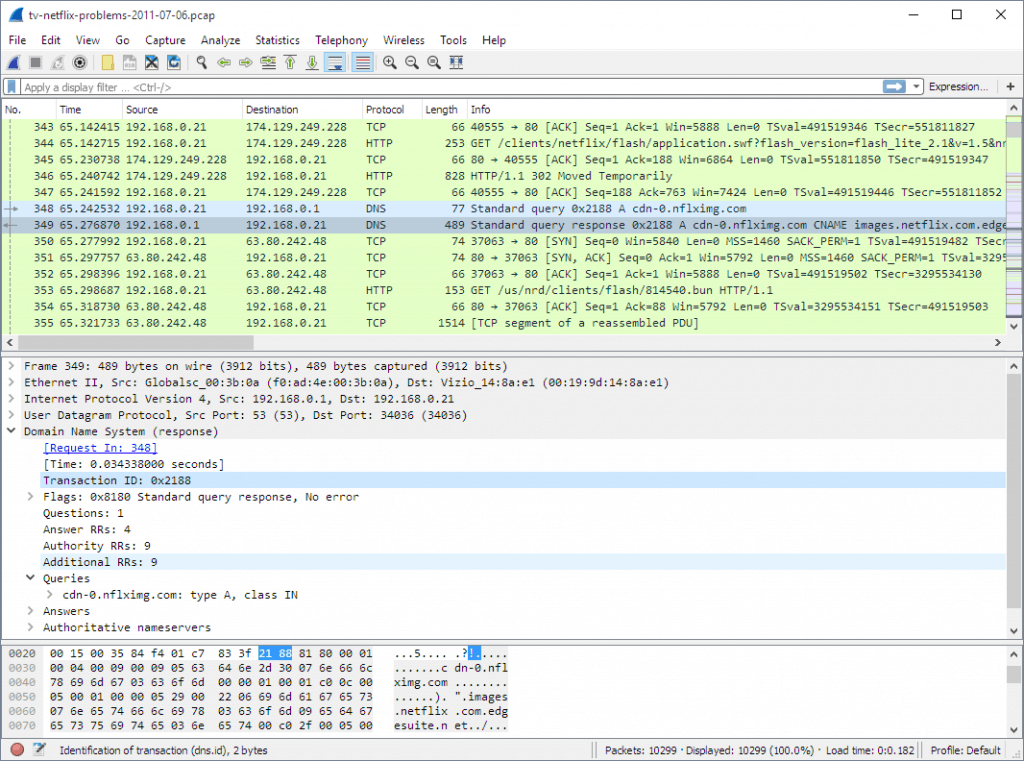
WireShark is a relatively new tool in the broad scheme of network diagnostics, and it does a great job finding a middle ground between raw data and visual representations of that data.
It's simple, it's compatible, it's portable. It does what needs doing and it does it succinctly.
It's got a clean UI, plenty of options for filtering and sorting, and, best of all for some of the multi-platform folks, it jives happily on any of the big three in terms of OS.
Add to that the fact that it's open-source and a Free Sniffer and you've got a compelling tool to reach for when you need some quick diagnostics. Available for *NIX, Windows, and OSX environments.
Pros:
- One of the most popular packet analyzer tools, with a massive community behind it
- Open-source project that adds new features and plugins
- Supports packet collection and analysis in the same program
- Completely free
Cons:
- Has a steep learning curve, designed for network professionals
- Filtering can take time to learn, collects everything by default which can be overwhelming on large networks
Download & More Information: https://www.wireshark.org/
4. tcpdump
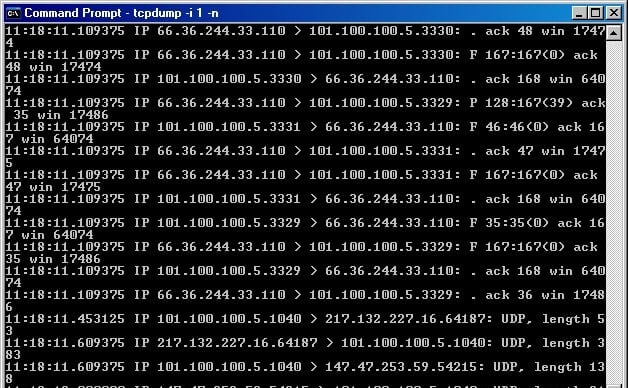
Tcpdump is something of an older tool and, to be frank, it looks like it. But there's a certain power in tools that are so cut and dry – it does what it needs to do, does it with as little a footprint as possible, and does it cleanly.
It may be harder for some professionals to weed through the stark tables of data, but in some environments, or on a machine barely running, minimal is best.
It's native and has its origins in the *NIX environment, but there are several Windows ports that do the job well.
It has all the functionality you'd want and need from a sniffer – capturing, recording, etc. – but it does lack a lot of the fancier capabilities of more robust software.
Tcpdump is often called for due to its sheer reliability and simplicity. Available for *NIX and Windows environments.
Pros:
- Open-source tool backed by a large and dedicated community
- Simple syntax is easy to learn, especially for users who are comfortable with CLI tools
- Lightweight application, utilizes CLI for most commands
- Completely free
Cons:
- Isn’t as user friendly as other options
- Uses a complicated query language for filtering
- Packet capture can only be read by applications that can read pcap files, not saved in plain text files
Download & More Information: http://www.tcpdump.org/
5. Kismet
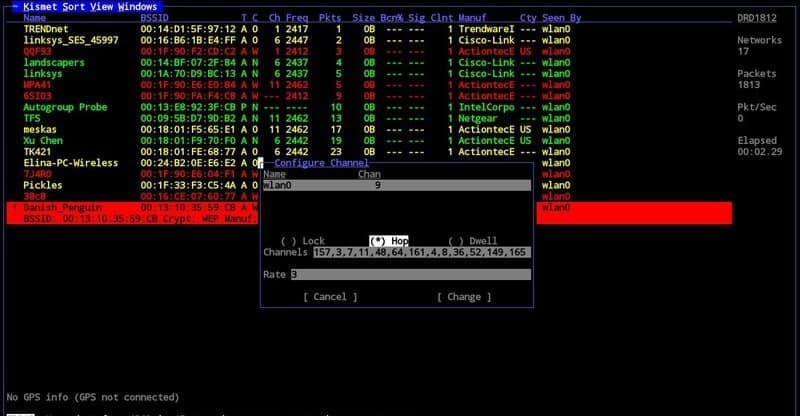
Kismet is more than just a packet sniffer and, in fact, delves into wide range of functionality.
Kismet even has the ability to sniff and analyze traffic of hidden networks or un-broadcasted SSIDs!
Tools like this can be strangely invaluable in the right circumstances when there's something unknown causing troubles and you can't just find it – Kismet can sniff it out, if it happens to be a rogue network or AP acting up nobody mentioned they setup not quite right.
As one can imagine by the nature of wireless networking it's a little more complex when it comes to sniffing, which is why a specialized tool like Kismet not only exists but is looked to frequently.
Kismet is an excellent go to if you've got a lot of wireless traffic and wireless devices and need a tool that's better suited to handling a wireless-heavy network. Available for *NIX, Windows Under Cygwin, and OSX environments.
Pros:
- Available for Linux, Mac, and OpenBSD
- Can scan for Bluetooth signals along with other wireless protocols outside of Wifi
- Allows for real-time packet capture that can be forwarded to multiple team members
- Uses plugins for additional features keeps the base installation lightweight
- Free to use
Cons:
- Designed for smaller networks
- Lacks enterprise-level reporting capabilities
- Reliant upon the open-source community for support and updates
Download & More Information: https://www.kismetwireless.net
6. EtherApe
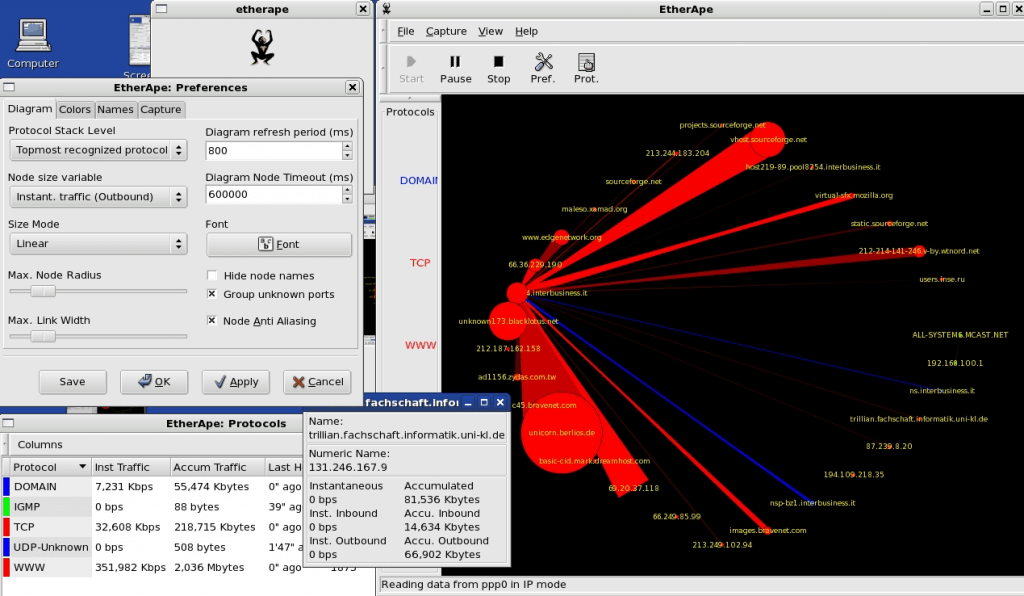
EtherApe has a lot of the same sort of functionality that WireShark does and, to boot, it also boasts being both Open-Source and free of any cost!
What makes it different, though, is that it's far more graphically driven.
Whereas WireShark has you peering at lists of numbers and comparing network throughput in a more numerical sense, EtherApe takes the focus more to the visual and graphical realm.
Some people just plain prefer the visual approach, and EtherApe tends to take precedence over WireShark for those folks. Available for *NIX and OSX environments.
Pros:
- Complete free
- Continuously updated
- Leverages simple but powerful data visualization to display information natively
- An open-source project
Cons:
- Only available for Linux, Unix, and MacOS
Download & More Information: http://etherape.sourceforge.net/
7. NetworkMiner
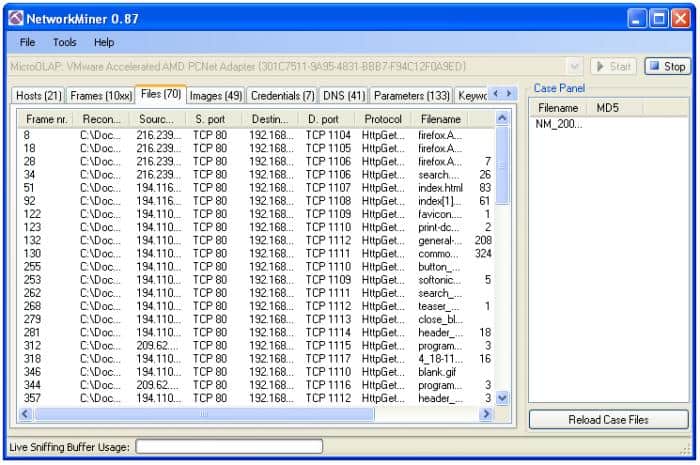
Network miner is another tool that does more than sniff and, arguably, would be better suited to ferreting out problematic users or systems on a network than overall diagnosis or monitoring as a whole.
Whereas other sniffers focus on the packets being sent back and forth, NetworkMiner is paying more mind to the ones doing the sending and receiving.
An excellent tool for finding problem machines or users.
Available for Windows environments only.
Pros:
- Acts as a forensic tool as well as packet sniffer
- Can reconstruct files and packets over TCP streams
- Does not introduce any noise to the network while in use, good for avoiding cross-contamination
- Free to use, includes a paid version for more advanced features
- Offers a GUI rather than only CLI
Cons:
- The interface is antiquated, and can be difficult to navigate at times
Download & More Information: http://www.netresec.com/?page=NetworkMiner
8. KisMAC
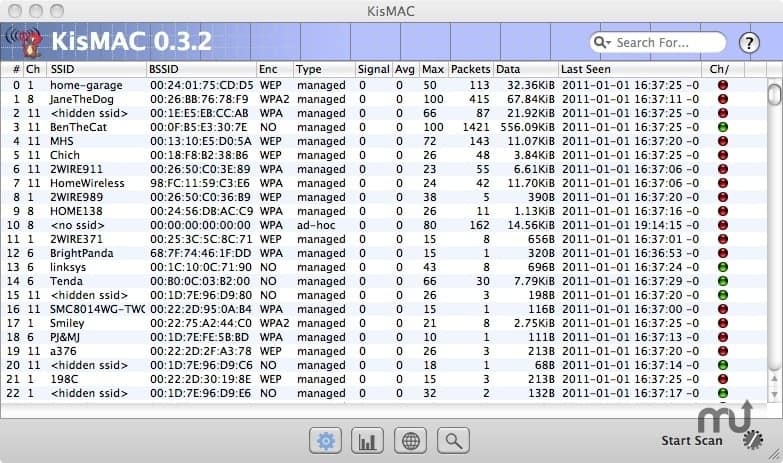
This software's name says it all – it's a lot like Kismet, but for the Mac environment. KisMAC! Simple as that.
These days Kismet has a Mac environment port, so it may seem redundant, but it's worth emphasizing that KisMAC actually has its own codebase and was not directly derivative from Kismet's.
Of particular note is that it offers several mapping and de-auth features on Mac that Kismet itself doesn't provide, and due to its unique codebase you may find it does the job better than Kismet itself at times. Available for OSX environments only.
Pros:
- Designed to run natively on MacOS – great tool for a Windows alternative
- Designed to capture and replay wireless packets – great for wireless security
- Displays data within the program through heatmapping, which is also useful for identifying rogue APs
Cons:
- Would like to see more supported hardware chipsets
Download & More Information: http://www.igrsoft.com/en/kismac2
Conclusion
Using Network Analyzers and Packet Sniffers will become a necessary tool when you have network issues of almost any kind – whether it's performance, dropped connections, or issues with network-based backups.
Just about anything that involves transmitting or receiving data on the network can often be fixed using some clues from the above software.
Packet sniffing is invaluable when you've got to really dig down beyond the top layer of a problem to get a better picture of what's happening, or what isn't happening and should be!
Packet Sniffers & Network Analyzers FAQs
What features do packet sniffers provide?
Packet sniffers provide features such as capturing and decoding network packets, analyzing network traffic patterns, and troubleshooting network issues.
What features do network analyzers provide?
Network analyzers provide features such as capturing and decoding network packets, analyzing network traffic patterns, monitoring network performance, and troubleshooting network issues.
Can packet sniffers be used to monitor encrypted network traffic?
No, packet sniffers cannot be used to monitor encrypted network traffic, as encryption makes the network traffic unreadable to packet sniffers.
How can packet sniffers and network analyzers help in troubleshooting network issues?
Packet sniffers and network analyzers help in troubleshooting network issues by providing detailed information about network traffic and performance, which can be used to identify and resolve network problems.
What's the difference between a packet sniffer and a network analyzer?
The main difference between them is the level of detail and functionality they provide. A packet sniffer is a tool that captures network packets and provides information such as the source and destination of the packets, the size of the packets, and the type of traffic.
A network analyzer provides a more comprehensive view of network traffic and performance. In addition to capturing network packets, network analyzers provide features such as traffic analysis, performance monitoring, and troubleshooting.
What should you look for in a packet sniffer and network analyzer?
- The ability to communicate with switches and routers using NetFlow, sFlow, J-Flow, and Netstream
- Suitability for multi-vendor environments
- An alerting system to warn of potential bottlenecks
- Traffic shaping measures, such as queuing methodologies
- The option to analyze network packets by sorting, filtering, grouping, and searching
- A way to try paid network analyzers for free
- Tools that work and are not a waste of time installing

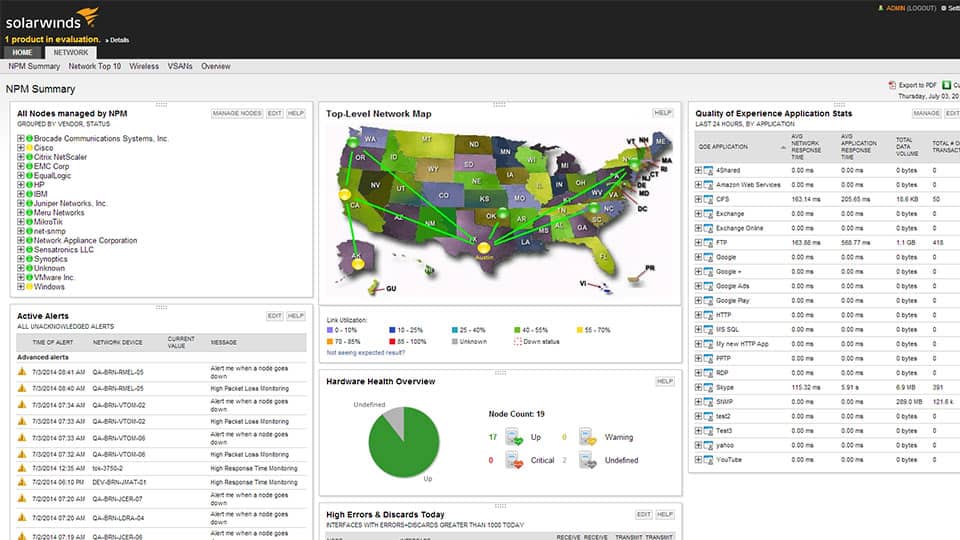
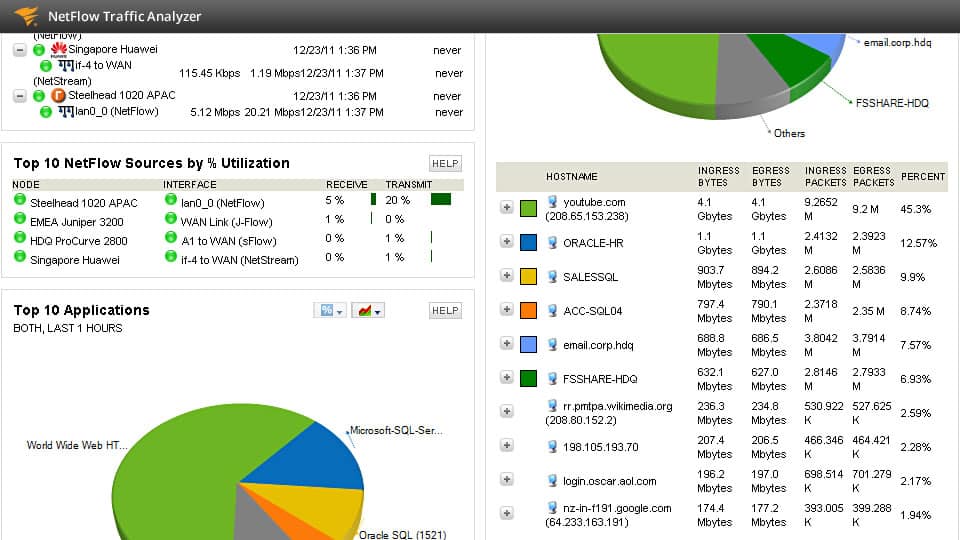
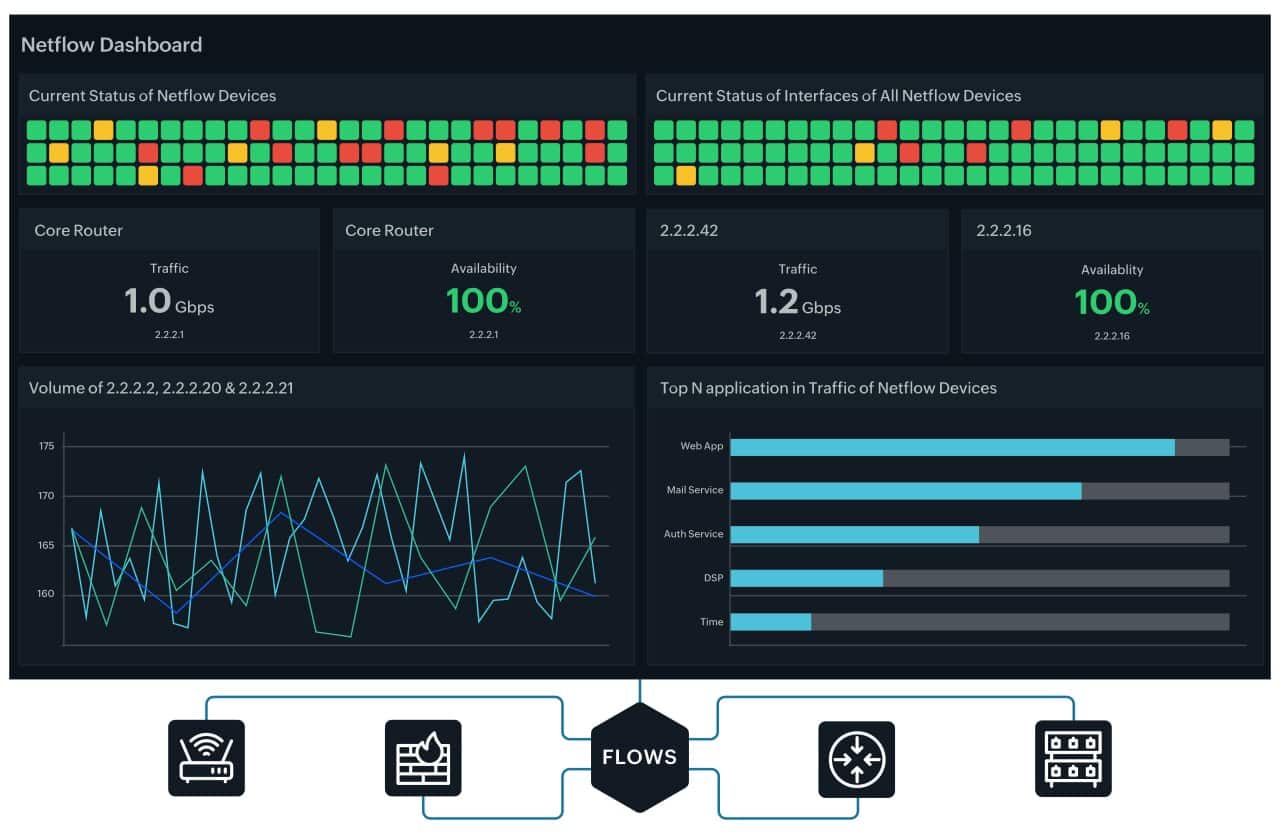



2. ManageEngine NetFlow Analyzer – FREE-TRIAL
ManageEngine has recently updated its NetFlow Analyzer to give you greater insights in your network traffic and bandwidth to see whats really going on in your networks.
With capabilities that allow you to weed out bandwidth hogs and resource heavy applications, you'll be happy to you chose this product over ones that dont give you historical data.
This ManageEngine product gives you detailed views into the packets that go through your networks and help you analyze them further.
Protocols and Capabilities include:
Pros:
Cons:
Click the link below to get started today with a 30-day free trial of this product in your network!
https://www.manageengine.com/products/netflow/index-new.html
ManageEngine NetFlow Analyzer Start a 30-day FREE Trial